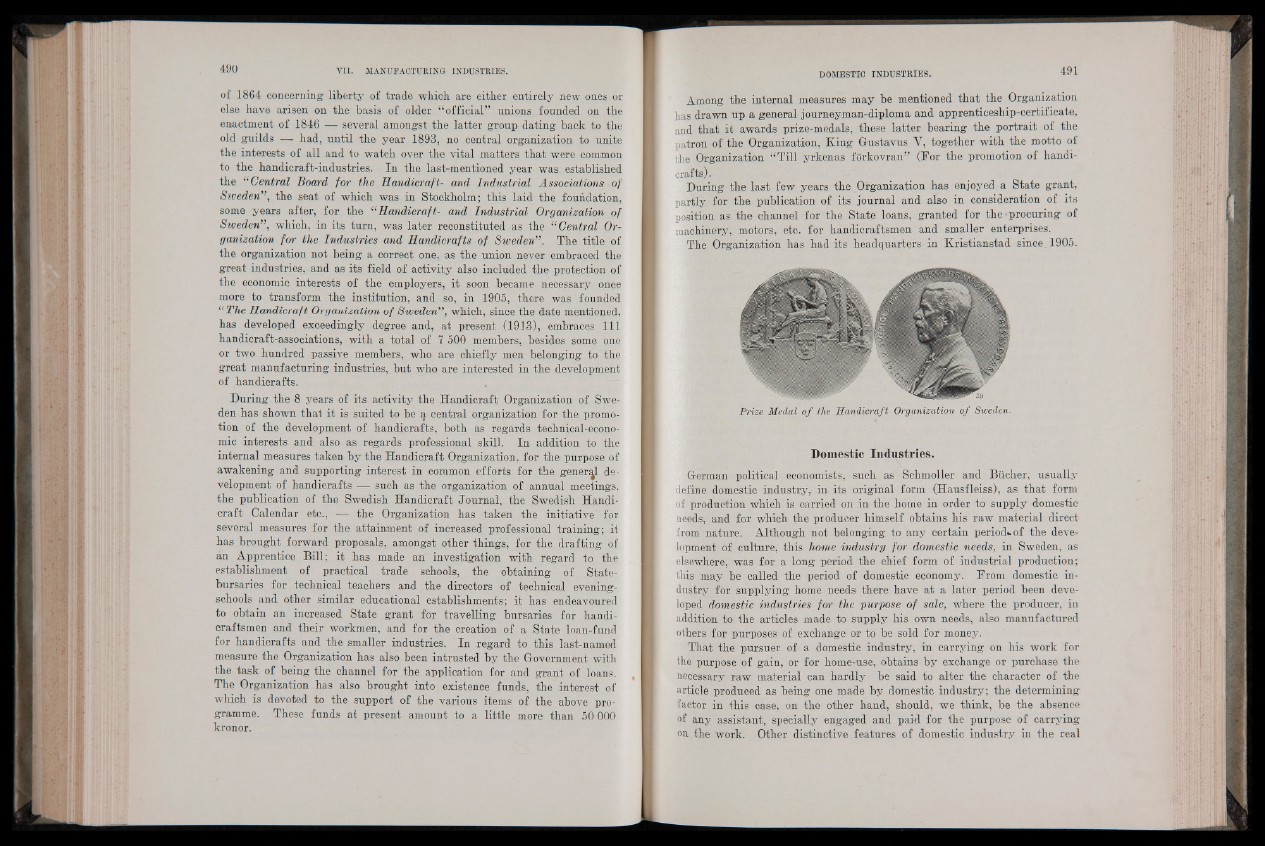
of 1864 concerning liberty of trade which are either entirely new ones or
else have arisen on the basis of older “ official” unions founded on the
enactment of 1846 — several amongst the latter group dating back to the
old guilds — had, until the year 1893, no central organization to unite
the interests of all and to watch over the vital matters that were common
to the handicraft-industries. In the last-mentioned year was. established
the “Central Board for the Handicraft- and Industrial Associations of
Sweden”, the seat of which was in Stockholm; this laid the foundation,
some years after, for the “Handicraft- and Industrial Organisation of
Sweden”, which, in its turn, was later reconstituted as the “Central Organisation
for the Industries and Handicrafts of Sweden”. The title of
the organization not being a correct one, as the union never embraced the
great industries, and as its field of activity also included the protection of
the economic interests of the employers, it soon became necessary once
more to transform the institution, and so, in 1905, there was founded
“The Handicraft Organisation of Sweden”, which, since the date mentioned,
has developed exceedingly degree and, at present (1913), embraces 111
handicraft-associations, with a total of 7 500 members, besides some one
or two hundred passive members, who are chiefly men belonging to the
great manufacturing industries, but who are interested in the development
of handicrafts.
During the 8 years of its activity the Handicraft Organization of Sweden
has shown that it is suited to be a central organization for the promotion
of the development of handicrafts, both as regards technical-economic
interests and also as regards professional skill. In addition to -the
internal measures taken by the Handicraft Organization, for the purpose of
awakening and supporting interest in common efforts for the general development
of handicrafts such as the organization of annual meetings,
the publication of the Swedish Handicraft Journal, the Swedish Handicraft
Calendar etc., — the Organization has taken the initiative for
several measures for the attainment of increased professional training; Jit
has brought forward proposals, amongst other things, for the drafting of
an Apprentice Bill; it has made an investigation with regard to the
establishment of practical trade schools, the obtaining of State-
bursaries for technical teachers and the directors of technical evening-
schools and other similar educational establishments; it has endeavoured
to obtain an increased State grant for travelling bursaries for handicraftsmen
and their workmen, and for the creation of a State loan-fund
for handicrafts and the smaller industries. In regard to this last-named
measure the Organization has also been intrusted by the Government with
the task of being the channel for the application for and grant of loans.
The Organization has also brought into existence funds, the interest of
which is devoted to the support of the various items of the above programme.
These funds at present amount to a little more than 50 000
kronor.
Among the internal measures may be mentioned that the Organization
has drawn up a general journeyman-diploma and apprenticeship-certificate,
and that it awards prize-medals, these latter bearing the portrait of the
patron of the Organization, King Gustavus Y, together with the motto of
the Organization “Till yrkenas forkovran” (For the promotion of handicrafts).
During the last few years the Organization has enjoyed a State grant,
partly for the publication of its journal and also in consideration of its
position as the channel for the State loans, granted for th e ‘procuring of
machinery, motors, etc. for handicraftsmen and smaller enterprises.
The Organization has had its headquarters in Kristianstad since. 1905.
Prize Medal o f the Handicraft Organization o f Sweden.
Domestic Industries.
German political economists, such as Schmoller and Bucher, usually
define domestic industry, in its original form (Hausfleiss), as that form
of production which is carried on in the home in order to supply domestic
needs, and for which the producer himself obtains his raw material direct
from nature. Although not belonging to any certain period«, of the development
of culture, this home industry for domestic needs, in Sweden, as
elsewhere, was for a long period the chief form of industrial production;
this may be called the period of domestic economy. From domestic industry
for supplying home needs there have at a later period been developed
domestic industries for the purpose of sale, where the producer, in
addition to the articles made to supply his own needs, also manufactured
others for purposes of exchange or to be sold for money.
That the pursuer of a domestic industry, in carrying on his work for
the purpose of gain, or for home-use, obtains by exchange or purchase the
necessary raw material can hardly be said to alter the character of the
article produced as being one made by domestic industry; the determining
factor in this case, on the other hand, should, we think, be the absence
of any assistant, specially'' engaged and paid for the purpose of carrying
on the work. Other distinctive features of domestic industry in the real